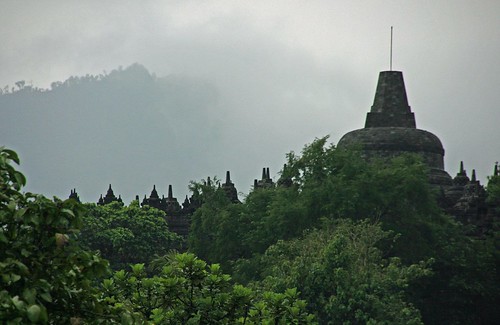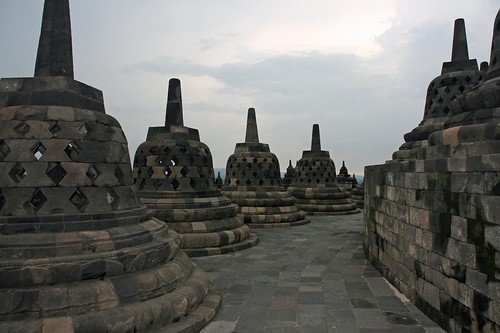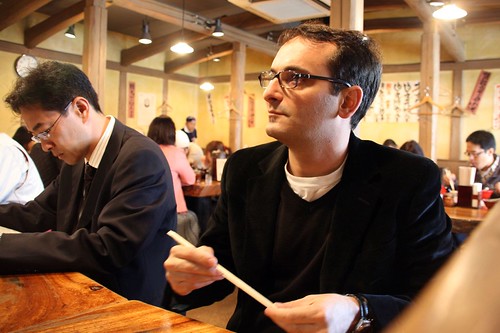Borobudur by Bus
There’s a certain amount of celebrity in being a traveler in some parts of the world. In India, it’s common for groups to gather to watch foreigners. In the public baths in Japan, my chest hair and privates were the focus of intense scrutiny. And from my visit yesterday to the Buddhist temple at Borobudur, where I was one of a handful of Western visitors, there will be pictures of me scattered across Asia, posing with people who don’t know my name.
The main reason I came to Yogyakarta in central Java is to visit Borobudur. Built in the 9th century, the origins of this massive Buddhist temple are somewhat of a mystery. How it was built, why it was built and by whom is not really known. What is known is that the temple was abandoned with the decline of Buddhism in the 14th century, reclaimed by the jungle and deserted for centuries, then rediscovered in 1814 by Sir Thomas Raffles, the British ruler of Indonesia. (More on Raffles later when I visit the famous Raffles Hotel in Singapore.)

Borobudur
The temple was in bad shape when it was discovered, as natural forces eroded the carvings and warped the structure itself. Between 1972 and 1985, several countries joined forces to restore the temple. It is now a UNESCO World Heritage Site and Indonesia’s most visited tourist attraction.
I decided to make my personal pilgrimage to Borobudur on local transportation. Hotels and travel agencies offer package tours, and the touts outside my Yogya hotel were more than willing to take me there for about $20. Public transportation is about $2 for the round trip. But it’s not about the money; it’s experience I was after.
I set out from my hotel for Giwangang Bus Station in the southern corner of the city. A taxi driver at the information desk told me I didn’t want to take a bus because a taxi is cheaper. This was another in the long line of exaggerations, perhaps outright lies, I’ve been fed by locals since arriving in Indonesia. While looking for a hotel in Yogya with a hot shower, I was told three times that I don’t want a hot shower because the weather is too hot here. I was also told I should take a tour to Borobudur because the temple is too far from the bus station. I've also been told not to order certain foods because it will be too spicy for my delicate American palette. Or, as was the case in Probolinggo, I should get scammed because the bus station is too dangerous for me. Whatever line I’m sold, I’m suspicious of all information and have learned to trust my instincts.
But I digress. The bus to Borobudur was a broken-down affair, with hard seats and the distinct smell of motor oil and cigarettes. The hour-long ride was a heart-stopping race through city and country, the driving weaving through traffic while passengers were given little time to hop on and off. A complex series of shouts and knocks from the driver’s assistant, who was leaning out the open door, somehow conveyed when to slow down or speed up. The bus never seemed to stop for passengers, just slow down so they could hop on or off at a quick trot.
This is the way it works here. There are lines on the streets, but directions are arbitrary. If a driver can make use of a few centimeters of road, he will. Two lanes become three, with kids on bicycles or becaks taking up the space on the shoulders. The death rate on the roads must be astronomical. I assume it's similar in other parts of SE Asia.
Upon arrival at the Borobodur, it's a quick becak ride from the bus station to the temple. The becak driver tells me it’s two kilometers to the temple and we agree on 5000 Rupiah (55 cents) for the ride. The distance is more like half a kilometer and should have been 2000 Rp. Again, what’s with the disinformation? Is everyone on the take in this country?
When I go to buy a ticket into Borobudur, my suspicions are reinforced. Indonesians pay 10,000 Rp to enter while foreigners pay 100,000. They are also happy to accept $11 U.S.
I suck it up and enter the grounds, ignoring the guides offering their services (“to know the right story”) and the hawkers selling pens, shirts, kites, snacks, carvings and fans.
On one level Borobudur is just a big pile of carved rocks. Or it’s an interesting religious site and a to admire ancient art. And I am intrigued by the story of loss, discovery and restoration. Borobudur works on many levels (no pub intended).
The temple itself is as spectacular as a pile of rocks can be. I slowly make my way around each of the temples levels, six square ones with carved reliefs and seated Buddha statues, and three circular ones at the top featuring stupas. My camera gets a work out as I admire the carvings for their aesthetic value rather than their specific meanings. The photos suffer from a lack of sunlight; perhaps the darkness adds to the mystery of the location.
When I arrive at the top, I take time to sit and enjoy the scene. There are clouds rolling in and I know it won’t be long before the rain starts.
Remember how I said travel involves a degree of celebrity? While sitting at the top of Borobudur I’m approached by other tourists and asked to pose for pictures. A family wants a picture. Some members of a military outfit want a picture. Others seem to want a picture but are too shy to ask.

Stupas
As I make my way down, I again take time to admire some of the carvings. I’m then approached by a group of high school girls who want to interview me. They are from a school about 40 kilometers away and are at Borobudur to practice their English. I’m more than happy to oblige and enjoy the conversation and the attention. They are delighted to find out I’m American (“We thought you were from India”) and fascinated by my past experience as a journalist. They are all smiles when we pose for photos and want me to come visit them at their school. I should have agreed immediately and regret later that I did not arrange a visit.

Students Posing
When the rain arrives I scurry for cover. After 30 minutes it lets up and I make my way outside the complex and into a large area devoted to selling souvenirs and food. Famished from my long bus ride and climbing on the temple, I find a stall and order Bakso Mie, noodle soup with meatballs. The woman at the next stall tries to sell me some ugly batik t-shirts with a terrible Borobudur stencil design. I deflect all the hawkers inquiries and engage the women in teaching me Indonesian, mostly words for food but a few pleasantries as well. The batik woman doesn’t let up though, and periodically exclaims “Oh Allah” as I keep refusing her lower and lower offers. They are a friendly bunch and the women who served me lunch says “Goodbye, my love” with a big smile when I leave. I guess you can learn English from television and movies.
The ride back to Yogya is just as harrowing, if not more so because of the driving rain. If there are speed limits on Indonesian roads, they are not observed. The bus driver must have been in a hurry because he refused to slow down if not necessary. At one point an old man gets on the bus and starts singing for spare change. He’s got a creaky old voice and the song sounds out of tune, but I give him a 500 Rp coin anyways, probably because of nostalgia for the New York City subway.
The day complete, I eat dinner at a padang in Yogya and settle in for my first night of good sleep in about five days.
The main reason I came to Yogyakarta in central Java is to visit Borobudur. Built in the 9th century, the origins of this massive Buddhist temple are somewhat of a mystery. How it was built, why it was built and by whom is not really known. What is known is that the temple was abandoned with the decline of Buddhism in the 14th century, reclaimed by the jungle and deserted for centuries, then rediscovered in 1814 by Sir Thomas Raffles, the British ruler of Indonesia. (More on Raffles later when I visit the famous Raffles Hotel in Singapore.)

The temple was in bad shape when it was discovered, as natural forces eroded the carvings and warped the structure itself. Between 1972 and 1985, several countries joined forces to restore the temple. It is now a UNESCO World Heritage Site and Indonesia’s most visited tourist attraction.
I decided to make my personal pilgrimage to Borobudur on local transportation. Hotels and travel agencies offer package tours, and the touts outside my Yogya hotel were more than willing to take me there for about $20. Public transportation is about $2 for the round trip. But it’s not about the money; it’s experience I was after.
I set out from my hotel for Giwangang Bus Station in the southern corner of the city. A taxi driver at the information desk told me I didn’t want to take a bus because a taxi is cheaper. This was another in the long line of exaggerations, perhaps outright lies, I’ve been fed by locals since arriving in Indonesia. While looking for a hotel in Yogya with a hot shower, I was told three times that I don’t want a hot shower because the weather is too hot here. I was also told I should take a tour to Borobudur because the temple is too far from the bus station. I've also been told not to order certain foods because it will be too spicy for my delicate American palette. Or, as was the case in Probolinggo, I should get scammed because the bus station is too dangerous for me. Whatever line I’m sold, I’m suspicious of all information and have learned to trust my instincts.
But I digress. The bus to Borobudur was a broken-down affair, with hard seats and the distinct smell of motor oil and cigarettes. The hour-long ride was a heart-stopping race through city and country, the driving weaving through traffic while passengers were given little time to hop on and off. A complex series of shouts and knocks from the driver’s assistant, who was leaning out the open door, somehow conveyed when to slow down or speed up. The bus never seemed to stop for passengers, just slow down so they could hop on or off at a quick trot.
This is the way it works here. There are lines on the streets, but directions are arbitrary. If a driver can make use of a few centimeters of road, he will. Two lanes become three, with kids on bicycles or becaks taking up the space on the shoulders. The death rate on the roads must be astronomical. I assume it's similar in other parts of SE Asia.
Upon arrival at the Borobodur, it's a quick becak ride from the bus station to the temple. The becak driver tells me it’s two kilometers to the temple and we agree on 5000 Rupiah (55 cents) for the ride. The distance is more like half a kilometer and should have been 2000 Rp. Again, what’s with the disinformation? Is everyone on the take in this country?
When I go to buy a ticket into Borobudur, my suspicions are reinforced. Indonesians pay 10,000 Rp to enter while foreigners pay 100,000. They are also happy to accept $11 U.S.
I suck it up and enter the grounds, ignoring the guides offering their services (“to know the right story”) and the hawkers selling pens, shirts, kites, snacks, carvings and fans.
On one level Borobudur is just a big pile of carved rocks. Or it’s an interesting religious site and a to admire ancient art. And I am intrigued by the story of loss, discovery and restoration. Borobudur works on many levels (no pub intended).
The temple itself is as spectacular as a pile of rocks can be. I slowly make my way around each of the temples levels, six square ones with carved reliefs and seated Buddha statues, and three circular ones at the top featuring stupas. My camera gets a work out as I admire the carvings for their aesthetic value rather than their specific meanings. The photos suffer from a lack of sunlight; perhaps the darkness adds to the mystery of the location.
When I arrive at the top, I take time to sit and enjoy the scene. There are clouds rolling in and I know it won’t be long before the rain starts.
Remember how I said travel involves a degree of celebrity? While sitting at the top of Borobudur I’m approached by other tourists and asked to pose for pictures. A family wants a picture. Some members of a military outfit want a picture. Others seem to want a picture but are too shy to ask.

As I make my way down, I again take time to admire some of the carvings. I’m then approached by a group of high school girls who want to interview me. They are from a school about 40 kilometers away and are at Borobudur to practice their English. I’m more than happy to oblige and enjoy the conversation and the attention. They are delighted to find out I’m American (“We thought you were from India”) and fascinated by my past experience as a journalist. They are all smiles when we pose for photos and want me to come visit them at their school. I should have agreed immediately and regret later that I did not arrange a visit.

When the rain arrives I scurry for cover. After 30 minutes it lets up and I make my way outside the complex and into a large area devoted to selling souvenirs and food. Famished from my long bus ride and climbing on the temple, I find a stall and order Bakso Mie, noodle soup with meatballs. The woman at the next stall tries to sell me some ugly batik t-shirts with a terrible Borobudur stencil design. I deflect all the hawkers inquiries and engage the women in teaching me Indonesian, mostly words for food but a few pleasantries as well. The batik woman doesn’t let up though, and periodically exclaims “Oh Allah” as I keep refusing her lower and lower offers. They are a friendly bunch and the women who served me lunch says “Goodbye, my love” with a big smile when I leave. I guess you can learn English from television and movies.
The ride back to Yogya is just as harrowing, if not more so because of the driving rain. If there are speed limits on Indonesian roads, they are not observed. The bus driver must have been in a hurry because he refused to slow down if not necessary. At one point an old man gets on the bus and starts singing for spare change. He’s got a creaky old voice and the song sounds out of tune, but I give him a 500 Rp coin anyways, probably because of nostalgia for the New York City subway.
The day complete, I eat dinner at a padang in Yogya and settle in for my first night of good sleep in about five days.
Labels: Indonesia



0 Comments:
Post a Comment
<< Home